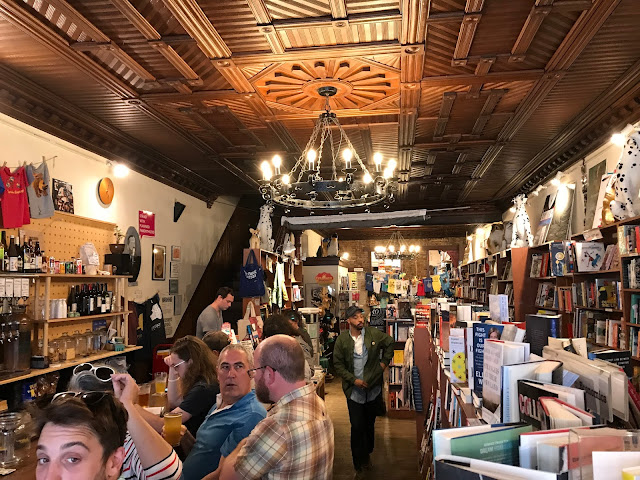Groundhog Day. We began to retrace our route down the Hudson River from Albany to the ocean. The first encounter would be the Federal Lock in Troy, the last one of the voyage. Unfortunately, a tug and barge beat us to it and we had to circle above. Sally took the time to take some high shots of Salty Paws.
Allan was at the helm maneuvering in place and must have lost track of Sally.
 |
| Anyone seen Sally? |
Albany is the northern terminus on the Hudson for most commercial traffic and the waterfront is full of large boats and industry.
So, we were surprised to see this sight across the way at the Albany Yacht Club; a throwback a few centuries to the days of Columbus and his ships the Niña and Pinta. These replicas are traveling museum projects of The Columbus Foundation, touring the western hemisphere. The Niña is the most historically accurate replication of this ship ever built. We were surprised by her deck length of only 65 feet. On the other hand, the Pinta at 85 feet is a larger version of the original and has a 40 foot air conditioned main cabin. It is available for private parties and charters.
We all agreed that Hudson, NY was a favorite stop. Moxie always attracted attention, particularly from Jack Russell owners. This admirer was a fashionably dressed landlubber, compared to the more casual and practical attire preferred by boaters.
These Hudson firemen enjoyed the sidewalk parade. Was the sign overhead an accurate depiction of their expertise?
It seemed that a lot of repurposing has gone on in this town.
Allan found an atypical hardware store with everything you could have possibly needed in the last 75 years. After an hour of browsing, Sally had to pull him out under false pretenses in order to make our dinner reservation.
Meanwhile, Jeanne was mixing with the locals at the Spotty Dog Books & Ale. She had to meet us at the restaurant.
 |
| Henry the VIII: 6 Wives-9 Lives |
Moving down the river, we made a short stop to view the cats of Catskill. These are fundraising projects. Local artists are given blank flibreglas statues to decorate (which is an understatement.)
 |
| The Great Catsby |
Another favorite port is Kingston, NY. We tied to the dock in front of the Hudson River Maritime Museum. It was a weekend and the waterfront was full of people interested in boats of all kinds.
Due to the dock configuration, Bob might have appreciated a megaphone to conduct LNVT information sessions.
Even though this was a weekend, the dock was bustling with activity by volunteers at the Riverport Wooden Boat School, part of the museum. They recently completed a restoration of the sloop Clearwater, the boat built by folksinger Pete Seeger in the 1960s which cruised the Hudson River on a mission to bring attention to the river pollution and clean up the waters. http://www.clearwater.org/about/the-clearwater-story/
From our tugs we had front row seats watching the building of this beauty, a ⅓ replica of the Woody, a Hudson River sloop also built by Pete Seeger ten years after the Clearwater, to further awareness of the cleanup project and make the river accessible to more people.
Captain Jim Lanzarotta and friend Larissa stopped by to say "Hi".
 |
| Salty Paws passes this ship at anchor in the river near Hyde Park. |
It was good to see that the history and heritage of the Hudson River are being recognized and preserved; just as the Lake Champlain Maritime Museum works to promote and protect the lake. The river is a byway for many types of watercraft. The shoreline houses many historic landmarks. We stopped in Hyde Park to visit the Vanderbilt Mansion National Historic Site.
We arrived a bit late for the start of the tour and the ranger waived the $20 entry fee. Good thing! The mansion was undergoing a bit of cleaning and stabilization, leaving a lot to the imagination.
Would you have paid $20 to see this?
But that didn't stop Madge our tour guide of 35 years from painting a good picture of life during the Gilded Age, between the years 1880 and 1913-14. We came away with mixed feelings about the lifestyle of the privileged during this era. It ended abruptly with the institution of income tax and onset of World War I. The Vanderbilt families had 40 mansions and reportedly spent most of their money.
But we did gain an appreciation for the work of the architects and landscape artists of the times. Frederick and his wife Louise had no children and left the estate to a niece. She was unable to sell it, and upon a recommendation from neighbor Franklin D. Roosevelt donated it along with most of the original furnishings to the National Park Service. It remains intact as the Vanderbilts left it.
This was our second to last day on the river and emotions were starting to surface; nostalgia for the many past experiences, and anticipation for the excitement of the waters around New York City.
But we still enjoyed the Hudson landscapes. This is World's End, a dog leg just above West Point. This tug was making a tricky turn with the barge to head north. Looks like he's headed for the shore; but he made it.
West Point sits just below that dogleg, the only complex of buildings in the otherwise pristine landscape.
More river traffic. We prepared ourselves for the busy waters of the sixth borough.
























No comments:
Post a Comment